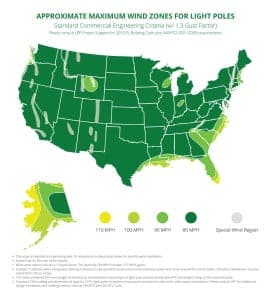The Effective Projected Area (EPA) wind rating of a fixture is one of those complicated, technical-heavy concepts of outdoor lighting that are nonetheless important. It’s so technically heavy that to some degree, wind ratings must be estimated for worse case scenarios. Why should property owners care about it then? The truth is, it’s not something that property owners will need to study in any detail, but it is something that they should expect their lighting providers to know. And it’s something that clients should expect their lighting providers to observe when selecting and installing fixtures.
What is Effective Projected Area?

But what is an EPA wind rating?
EPA wind ratings refer to how much force a particular fixture is engineered to handle during windy conditions. Depending on where the fixture is installed, it is expected to withstand certain worst-case wind conditions. Those worst-case conditions are defined by geographic regions. For example, cities along the coast, like Miami and Houston, are in 110 MPH wind zones. Any fixture mounted on a tall light pole will need to be able to handle 110 MPH winds without failure.
Every fixture has a unique drag profile when it is exposed to fast moving air. This drag profile is determined by a few factors, including:
- Wind pressure (a combination of wind velocity and air density)
- The fixture’s weight
- The fixture’s EPA
All of these factors determine how much force is applied to the fixture and its mounting hardware at any moment.
How is EPA wind rating calculated?
Factors like wind pressure are easy to measure and are well known. Worst-case historical wind pressure values are used as a stand-in when determining a fixture’s drag profile and wind rating, and this data has been collected over many decades.
Wind pressures are easy enough to calculate, but the fixture’s unique drag profile is harder to determine. The Projected Surface Area of the fixture is one primary factor in its drag profile, and this is calculated by mapping the fixture to a two-dimensional space. Its cross-sectional area is computed, and this is multiplied by the fixture’s drag coefficient. That gets you the EPA.
What’s the drag coefficient? Every shape has a unique drag coefficient that’s determined by a complex array of minute factors that can only be measured experimentally, like bringing the fixture into a wind tunnel and monitoring air flow changes around it. This is, of course, prohibitive for a fixture manufacturer, so lighting manufacturers have to also substitute in worse case values for certain fixture shapes, like flat plates or spheres.
In addition to wind pressure and the fixture’s drag coefficient, the fixture’s weight also factors into the fixture’s wind rating. As wind conditions worsen, a heavier fixture will exert more force on its mounting hardware. The fixture’s wind rating is adjusted accordingly.
All of these elements – wind pressure values, fixture weight and fixture EPA, are combined to assess a fixture’s wind rating.
Why is a fixture’s EPA rating so important?
An EPA wind rating isn’t something that property owners should have to research exhaustively, but it should be a point of discussion with lighting providers.
It goes without saying, but a property owner does not want fixtures that are likely to fail, so EPA is a critical element of the fixture selection process. A fixture’s EPA wind rating is the maximum wind velocity that a pole-mounted fixture is equipped to handle in a particular area. If the fixture’s wind rating is sufficient, the fixture and its mounting hardware are expected to withstand worst-case wind pressure conditions. In other words – a pole fixture that will remain safe even when the weather is applying maximum stress.
In areas where wind pressures can be severe, like along the coast and near mountains, a pole light’s EPA wind rating is a major safety concern. The lighting expert you work with should observe this concern.






